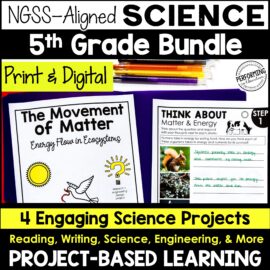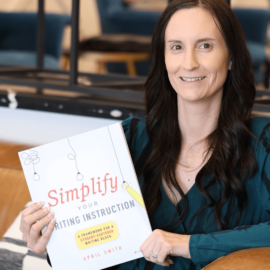Whether you’re new to project-based learning (PBL), or a seasoned pro, you’ve probably realized that ideas for teaching 21st-century competencies are difficult to find. Here are 4 ways that I’ve integrated 21st-century competencies into my project-based learning activities.
What are 21st-Century Competencies?
21st-century competencies have a pretty broad definition. They are any skills that prepare students for the challenge of life in our present society. The “4 Cs” are the most widely known competencies. These are:
- Critical Thinking
- Communication
- Collaboration
- Creativity
The “4 Cs” are ones that I find usually happen naturally within a well-planned PBL. However, a few of my ideas below really help increase the practice of these competencies within the lessons.
Any life and career skills are also considered 21st-century competencies. The same goes for media & technology skills. I’ve found that technology is a great way to incorporate a lot of the skills students need for today’s world if used in a collaborative manner.
Role-play
Role-playing is my #1 way to teach my students these competencies. Throughout every project, I have students act out different things to model my expectations.
Have students model the following through role-playing:
- How to effectively communicate with a teammate
- How to communicate with your audience
- How to work collaboratively, so that each person is contributing equally
- How to correctly use technology
- How to “think outside the box”
When a student displays behavior that showcases one of the competencies, ask them to repeat it in a role-play situation in front of the class. Any time you see an example of these come up during your project-based learning time, call attention to it. The more your students see these skills, the more likely they’ll be to use the skills themselves.
Blogging
Blogging is one of my favorite ways to incorporate multiple competencies because it’s easy for students to set up and use all year with every PBL we complete. At the beginning of the year, I set my students up on a blogging platform. My platform of choice last year was Blogger, but it’s often blocked by school spam filters, so you’ll definitely want to try it out from the student devices before trying to get your students set up. Here are some other ideas for platforms to use:
- WordPress
- Instagram (older students)
- Edmodo (your best bet for the younger kids)
- Weebly
- Kidblog
Before you introduce blogging in your classroom, try it out yourself on the platform you choose.
To correctly integrate 21st-century competencies using a blog, you’re going to want to do the following items:
- Have students collaborate on blogs, reading other student blogs and leaving thoughtful responses.
- Have students use the blogs to communicate with the audience of their PBL. They can send the link to their blogs and/or posts to their audience to give updates and request feedback.
- Allow students time to design their blogs. Create a framework for what content and design elements you want to be included, but encourage (and showcase) creativity.
- If you have older students, let them come up with the strategies they use for blogging and sharing content. I mentioned Instagram above. It’s a great way to have students mini-blog using a photo and short blurb, and students can come up with a hashtag to tie everyone’s posts together for easy communication.
Discussion
Any time during project based learning is a great time for a good discussion! Look for moments during the PBL where your students can engage in a lively discussion or debate. Use these discussions to model collaboration and communication. Here are a few ways to do so:
- Keep discussions purposeful.
- Teach students how to find a key takeaway from each discussion that can be used to revise their end products, or help change the way they think about the challenge.
- Teach students how to identify and work with experts. For example, if you’re listening to a class discussion about social sharing and one person seems very knowledgeable on Instagram hashtags, you want to remember this person when you get to a part of your project where you need a hashtag expert to help you out.
Voice & Choice
One of the many powerful things about project-based learning is that it allows students to make choices throughout. Teaching students to make sound choices is an important part of learning 21st-century competencies. Here are some choices that fit into any PBL that will help integrate these competencies:
- What media students use to collaborate and share results
- How the end products can be used locally and globally
- How to create products for an outside audience
Most importantly, allow students to make the wrong choice, so that you can help them learn from their mistakes. Teaching students how to evaluate their choices is an important part of the learning process.
Wrap-Up
As you work on PBL in your class, you’ll start to see a lot of opportunities for these ideas to be integrated. Your job as the facilitator of the project is to jump at any chance to work one of these competencies in. I hope you’ll enjoy helping your students learn 21st-century competencies as much as I have!


